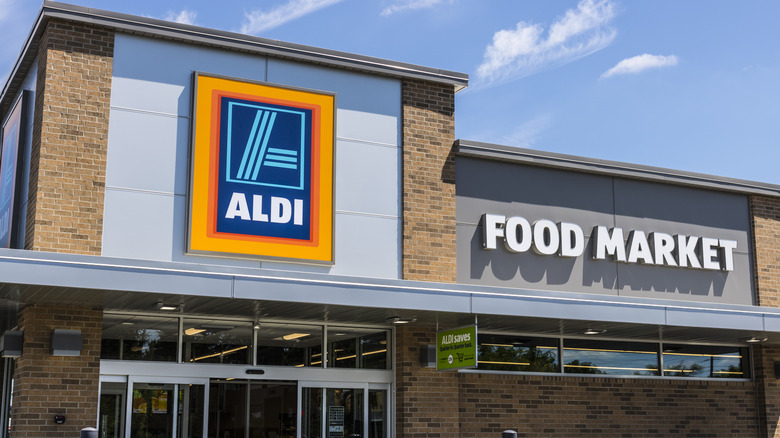How Many In-House Brands Does Aldi Have?
People hold pretty passionate opinions about their grocery shopping rituals. From time of day to shopping approach, to curbside vs. in-store shopping — everyone has their own style, but perhaps no element elicits such strong feelings as store preference. Everyone has a favorite that they swear is best. But with many feeling the sting of rising grocery store prices, more of us are joining the ranks of loyal Aldi devotees. According to Aldi, what started back in 1961 as a family-owned discount grocery store in Germany has now grown across the pond and around America with stores in 36 states, expanding year after year.
What sets Aldi apart from your typical supermarket is its commitment to keeping prices low. A major way that Aldi achieves these lower-than-standard prices is by stocking the shelves with its own brands, rather than bringing in national and small brands from outside owners. In fact, according to Supermarket News, around 90% of Aldi's products are in-house brands, although the exact number is hard to pin down, as it's always changing.
So, instead of the brand names you recognize gracing its shelves, you'll see items like Village Bakery baked goods, Reggano jarred pasta sauce, and Stonemill spices at Aldi. All of them sound, look, and taste just like the big name brands, the only difference is that they're owned by Aldi itself.
Aldi's business model is just built differently
Not only will you find shelves full of these Aldi-only brands when shopping at your local store, but you'll also surely notice that the vibes are different. You're not imagining it, and the no-frills look is all part of the plan. From the lack of dazzling displays, the fact that you'll be bagging your own groceries and bringing back your own cart (which means fewer employees), down to the layout of the stores themselves to help keep traffic flowing — these all mean fewer costs and a cheaper bottom line for you. These are trade-offs that Aldi knows its target market of shoppers will find well worth it.
While the ambiance is different, it's true that Aldi isn't the only major national grocery store to stock its own in-house brands. Just think about Good & Gather by Target or Walmart's Great Value. But it's a matter of numbers that sets Aldi apart. While in-house brands may be one option of many at stores like Target or Walmart, at Aldi, your options are almost entirely Aldi brands. According to a 2022 report by Numerator, around 20% of all food sold at Walmart — or 30% at Sam's Club — is private-label, compared to more than 75% of all items sold at Aldi coming from in-house brands. The next store behind it is Trader Joe's, which operates in a similar, atypical manner with the goal of keeping costs down for shoppers.
How in-house brands save Aldi (and you) big bucks
Thanks to its prioritization of in-house brands, Aldi remains at the top of the list of most affordable grocery stores. At most grocery stores, the process of bringing in products to stock shelves involves buyers, huge marketing budgets, and brand owners pitching their products and vying for shelf space. Aldi essentially cuts through most of this by stocking its own brands. Everyone saves by cutting out some of the middlemen, which means stripped-back displays and fewer overwhelming product options.
But recently, Aldi has introduced a section of big brands to cater to shoppers' loyalty. However, according to Aldi, this small section only comprises about 10% of the total store items. Aldi knows that its stores don't need name brands, though. Some of the best vegan foods are at Aldi exclusively, and the store has gained cult followings around many other viral in-house faves, from pantry staples to holiday drops.
While traditional grocery stores bank on customers flocking to their stores for the big brands they're loyal to, Aldi seems to be betting on the reverse type of loyalty. Aldi prides itself on making delicious, high-quality, in-house brands — not cheaper alternatives, but truly stand-out items — that will bring customers back to Aldi to find inexpensive products that they can't get elsewhere.


